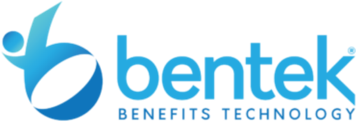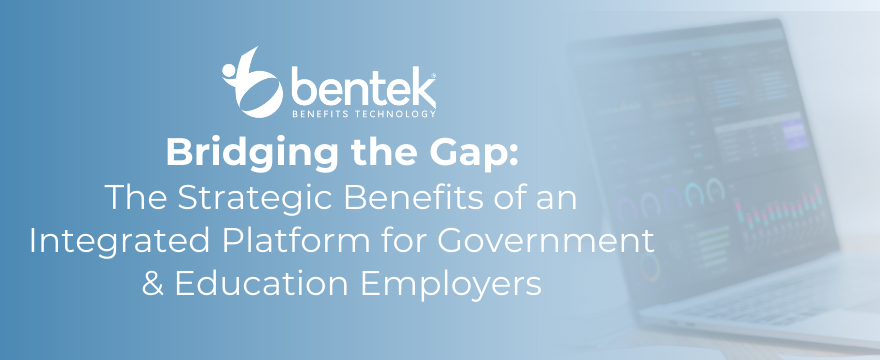In this interconnected world, the efficiency and effectiveness of an organization significantly depend on its ability to integrate and streamline processes across various departments. Today, an integrated platform for government and education employers connecting Benefits, HR, Finance, and Payroll departments is no longer a wish list items, it’s a strategic necessity.
This piece delves into the strategic importance of such a platform, highlighting its benefits, addressing communication challenges, and supporting claims with relevant statistics. Follow along as we explore the importance of integrated platforms for government and education.
Streamlined Operations and Increased Efficiency
An integrated platform allows seamless information flow between departments, reducing redundant data entry and minimizing errors. For instance, when the HR department updates employee information, these changes are automatically reflected in the Benefits, Finance, and Payroll systems. This automation reduces administrative burdens and allows staff to focus on more strategic tasks. According to Mercer, 69% of HR professionals plan to increase investment in digital benefit platforms to support benefit administration and communication in the next 1-3 years.
Enhanced Employee Experience
An integrated platform revolutionizes the employee experience for those in Benefits, HR, Finance, and Payroll departments. By streamlining processes and consolidating information, these departments can work more efficiently and effectively, leading to a more satisfying work environment.
Time Savings:
- One of the most significant advantages of an integrated platform is the time saved on routine tasks. With automated data synchronization, employees no longer need to manually update records across multiple systems. For example, when the HR department enters new employee information, these updates automatically reflect in the Benefits, Finance, and Payroll systems. This reduces the time spent on data entry and minimizes errors, allowing staff to focus on more strategic and value-added activities.
Improved Collaboration:
- Integrated systems foster better communication and collaboration among departments. With a unified platform, employees from Benefits, HR, Finance, and Payroll can easily access the same data and insights, reducing the need for back-and-forth communication and minimizing the risk of miscommunication. This seamless information flow ensures that everyone is on the same page, leading to more coordinated and effective decision-making.
Reduced Administrative Burden:
- The automation of routine tasks and processes significantly reduces the administrative burden on employees. For instance, benefits administrators can automate enrollment processes and compliance checks, while payroll professionals can automate calculations and deductions. This not only frees up time for more complex and strategic tasks but also reduces stress and increases job satisfaction.
Enhanced Data Accuracy:
- With an integrated platform, data accuracy is significantly improved. By having a single source of truth, discrepancies, and errors that often arise from maintaining multiple databases are eliminated. This leads to more reliable data for reporting and decision-making, reducing the risk of costly mistakes and enhancing the overall efficiency of the organization.
Better Resource Management:
- Integrated systems allow for better resource management by providing comprehensive insights into workforce and financial data. HR can better manage talent and plan for future needs, Finance can track and forecast budgets more accurately, and Payroll can ensure timely and accurate payments. This holistic view enables departments to work together more effectively, optimizing resource allocation and improving overall organizational performance.
Increased Agility:
- In today’s fast-paced environment, the ability to quickly adapt to changes is crucial. An integrated platform enhances organizational agility by providing real-time data and insights, enabling departments to respond swiftly to new regulations, policy changes, and other external factors. This ensures that the organization remains compliant and can quickly address any issues that arise, maintaining smooth and efficient operations.
Improved Decision-Making
Access to accurate, real-time data is critical for making informed decisions. An integrated platform offers a comprehensive view of the organization’s workforce and financial health. Decision-makers in Benefits, HR, Finance, and Payroll can access the data they need to analyze trends, forecast future needs, and develop strategies that align with organizational goals. This holistic view fosters collaboration and ensures all departments work towards the same objectives.
Compliance and Risk Management
Government and education employers must navigate complex regulations and compliance requirements. An integrated platform helps ensure all departments are in sync with the latest policies and procedures. Automated updates and notifications alert relevant staff to changes in laws or regulations, reducing the risk of non-compliance and associated penalties. Additionally, a centralized system enhances data security and ensures sensitive information is protected.
Cost Savings
By reducing manual processes and streamlining operations, an integrated platform can lead to significant cost savings. The automation of routine tasks reduces the need for additional staff and minimizes overtime expenses. Furthermore, the ability to quickly access and analyze data can uncover inefficiencies and identify areas for cost reduction. These savings can be redirected to other critical areas, such as employee development and infrastructure improvements.
Additionally, consolidating systems and adopting integrated platforms can substantially lower IT costs. According to NetSuite, ERP systems, which serve as a backbone for integrating various departmental functions, have shown that 46% of businesses achieve cost savings, and 40% report reduced IT costs post-implementation
Promoting Collaboration and Innovation While Breaking Free from Department Silos
An integrated platform fosters a culture of collaboration and innovation by breaking down silos between departments. When Benefits, HR, Finance, and Payroll work together seamlessly, they can develop more comprehensive and innovative solutions to organizational challenges. For instance, a collaborative approach to benefits design can result in programs that are more aligned with employee needs and organizational goals.
For government and education employers, an integrated platform that connects Benefits, HR, Finance, and Payroll departments is not just a tool but a strategic asset. By streamlining operations, enhancing the employee experience, improving decision-making, ensuring compliance, achieving cost savings, and promoting collaboration, such a platform can bridge the gap between departments and drive organizational success. Investing in this technology is an investment in the future, ensuring that theseⓇ critical employers can meet the challenges of today and tomorrow with agility and confidence.
For more articles like this one, check out the Bentek® Blog!




